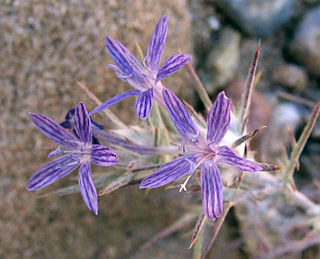
Eriastrum densifolium is a species of flowering plant in the phlox family known by the common name giant woollystar. This wildflower is native to California and Baja California where it grows in open areas such as sand dunes and dry washes. It grows on an erect stem with slightly hairy to densely woolly foliage, often giving the plant a dark gray-green color. The leaves are narrow and spike-shaped with pointed lobes. The top of each stem is occupied by a bunched inflorescence full of woolly leaflike bracts and funnel-shaped, flat-faced flowers. The flowers are each 1 to 3 centimeters long with a face up to three or four centimeters wide. The lobes are white to bright, striking blue, sometimes with longitudinal pinstripes. The stamens protrude from the throat.

Chorizanthe cuspidata is a species of flowering plant in the buckwheat family known by the common name San Francisco spineflower. It is endemic to California, where it is known only from the San Francisco Bay Area and to the immediate north and south. It grows in sandy coastal habitat.
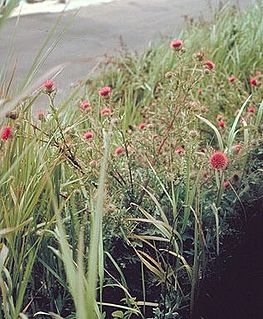
Cirsium andrewsii is an uncommon species of thistle known by the common name Franciscan thistle. It is endemic to California, where it is known from the coastline of the San Francisco Bay Area from Marin to San Mateo Counties. There are also reports of isolated populations in the Klamath Mountains and in the Sierra Nevada.
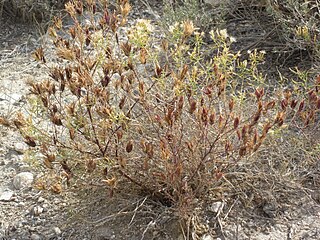
Cordylanthus ramosus is a species of flowering plant in the family Orobanchaceae known by the common name bushy bird's beak. It is native to the western United States where it grows in mountains and plateau, including the sagebrush of the Great Basin. It is an annual herb producing an erect, branching gray-green form, often tinted with red, becoming bushy at its most robust and appearing not unlike a sagebrush. The small leaves are narrow and linear or divided into several narrow, thready lobes. The inflorescence is a small spike of a few flowers surrounded by bracts which are linear or divided into narrow, thready lobes like the leaves. The bracts are faintly woolly and occasionally bristly in texture. The flower is one to two centimeters long with a hairy yellow pouch enclosed in darker, tougher reddish sepals. This plant had a number of historical medicinal uses for the Navajo people, who used it as an emetic.

Crepis acuminata is a North American species of flowering plant in the daisy family known by the common name tapertip hawksbeard. It is native to the western United States where it grows in many types of open habitat.

Crepis intermedia is a North American species of flowering plants in the daisy family known by the common name limestone hawksbeard. It is native to the Pacific Northwest, Columbia Plateau, Great Plains and Southwestern regions of western North America.
Eriastrum abramsii is a species of flowering plant in the phlox family known by the common name Abrams' woollystar. The epithet abramsii commemorates LeRoy Abrams. It is endemic to California, where it is known from the hills of the Coast Ranges in and around the San Francisco Bay Area. It is an annual herb producing a thin, usually woolly stem up to about 15 centimeters tall. The leaves are divided into several narrow, threadlike linear lobes. The inflorescence is a woolly cluster of narrow, leaflike bracts laced with webby fibers. The small flowers have yellow throats and white or blue corolla lobes.
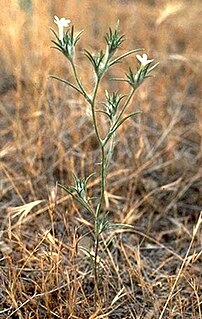
Eriastrum brandegeeae is a species of flowering plant in the phlox family known by the common name Brandegee's woollystar. It is endemic to California, where it is known from the chaparral and woodlands of the North Coast Ranges, generally on volcanic soils. There have been specimens collected from the San Francisco Bay Area which are closer to this species than other Eriastrum, but may actually be a new species. This is an annual herb producing a thin, usually woolly stem up to about 30 centimeters tall. The leaves are divided into several narrow, threadlike linear lobes. The inflorescence is a woolly cluster of narrow, leaflike bracts laced with webby fibers. The small flowers have white to light blue corollas.
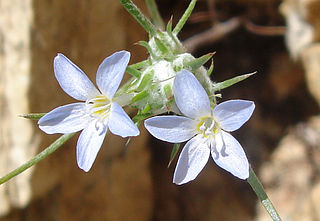
Eriastrum diffusum is a species of flowering plant in the phlox family known by the common name miniature woollystar. It is native to the southwestern United States from California to Texas, where it grows in many types of open habitat. This is an annual herb producing a thin, usually woolly stem up to about 20 centimeters long, growing erect or spreading outward. The leaves are divided into 2 to 4 narrow, threadlike linear lobes. The inflorescence is a woolly cluster of narrow, leaflike bracts laced with webby fibers. The small flowers are funnel-shaped, with yellowish throats and white to pale blue corollas.
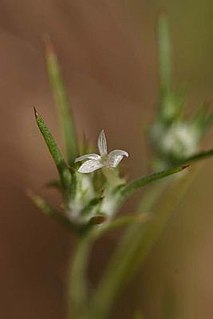
Eriastrum hooveri is a rare species of flowering plant in the phlox family known by the common name Hoover's woollystar. It is endemic to the South Coast Ranges of California from San Benito to Los Angeles Counties, where it grows in grassy open habitat. It is an annual herb producing a wiry, usually woolly stem up to about 15 centimeters tall. The leaves are linear and threadlike, less than three centimeters long, and sometimes divided into two thready lobes. The inflorescence is a woolly cluster of narrow, leaflike bracts laced with webby fibers. The flowers are white and just a few millimeters in length.
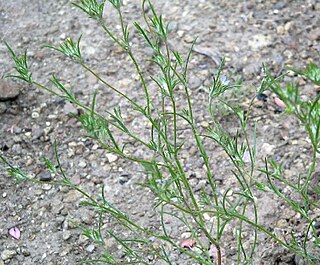
Eriastrum wilcoxii is a species of flowering plant in the phlox family known by the common name Wilcox's woollystar. It is native to the western United States, where it grows in various types of desert and plateau habitat. It is an annual herb producing a thin, branching, usually woolly stem up to about 30 centimeters tall. The leaves are narrow and thready, up to 3 centimeters long, and sometimes divided into two or more lobes. The inflorescence is a woolly cluster of narrow, leaflike bracts laced with webby fibers. The small flowers have yellow throats and blue corollas with lobes up to half a centimeter long.

Constancea is a monotypic genus of flowering plants in the family Asteraceae containing the single species Constancea nevinii, which is known by the common name Nevin's woolly sunflower. It is endemic to three of the Channel Islands of California, where it grows in coastal scrub habitat. This is a small shrub or subshrub generally growing up to one or 1.5 meters tall, and taller when an erect form, with a branching, woolly stem. The whitish, woolly oval leaves may be up to 20 centimeters long and are divided into many narrow lobes with edges curled under. The inflorescence is a cluster of 10 to 50 or more small flower heads, each on a short peduncle. The flower head has a center of hairy, glandular, star-shaped yellow disc florets and a fringe of four to nine yellow ray florets, each about 2 millimeters long. The fruit is an achene a few millimeters long with a small pappus at the tip.

Lessingia lemmonii is a species of flowering plant in the family Asteraceae known by the common name Lemmon's lessingia. It is native to the western United States around the intersection of Nevada, Arizona, and California, where it grows in desert and other habitat with sandy soils. This is an annual herb producing gray-green woolly stems in a low clump just a few centimeters high to a relatively erect 40 centimeters tall. The leaves are narrow and small, under 2 centimeters long, with much larger leaves appearing around the base of the young plant and withering away early. The flower heads appear singly or in open arrays. Each head has a bell- to bullet-shaped involucre lined with hairy to woolly phyllaries. The head is discoid, containing no ray florets but many funnel-shaped yellow disc florets with long lobes. The florets often have white markings in the throats. The fruit is an achene with a whitish or brownish pappus of bristles.

Lessingia leptoclada is a species of flowering plant in the family Asteraceae known by the common name Sierra lessingia. It is endemic to the Sierra Nevada of California, where it is known from several types of local habitat. This is a slender annual herb growing erect and varying in size from just a few centimeters to nearly a meter tall, with long, spreading branches. It is very glandular and often hairy or woolly in texture. The upper leaves are up to 5 centimeters long, narrow and sometimes toothed or lobed; the lower leaves are longer and wither early. The flower heads appear singly or in small clusters. Each head is lined with woolly phyllaries. The head is discoid, containing no ray florets but many funnel-shaped pinkish, lavender, or light bluish-purple disc florets with large lobes. The fruit is an achene with a whitish pappus of bristles.
Lessingia virgata is a species of flowering plant in the family Asteraceae known by the common name wand lessingia. It is endemic to California, where it is known from the eastern side of the Central Valley and adjacent Sierra Nevada foothills. It is a woolly, glandular annual herb growing up to about 60 centimeters tall with slender, spreading branches. The upper leaves are no more than a centimeter long, while the lower ones are longer and sometimes divided into lobes or teeth. The flower heads appear singly in leaf axils, each lined with purple-tipped, glandular, woolly phyllaries. The head is discoid, containing no ray florets but a few tubular light lavender to nearly white disc florets with long, narrow lobes. The fruit is an achene with a whitish pappus on top.
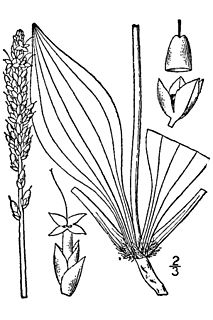
Plantago eriopoda is a species of plantain known by the common name redwool plantain. It is native to much of western and central North America from Alaska to the southwestern United States to the Great Lakes region, where it can be found in moist and wet habitat types, sometimes in alkaline soils. It is a perennial herb producing a clump of lance-shaped to narrow oval leaves up to 25 centimeters long. The leaves may have slightly toothed edges and often have a coating of woolly red hairs near their bases. The stemlike inflorescences grow erect to a maximum height near half a meter. Atop the peduncle of the inflorescence is a dense cylindrical spike of many tiny flowers. Each flower has a whitish corolla with four lobes each about a millimeter long accompanied by sepals covered with small bracts.
Scrophularia atrata is an uncommon species of flowering plant in the figwort family known by the common names black-flowered figwort and darkflowered figwort. It is endemic to California, where it is known only from a section of the Central Coast Ranges in San Luis Obispo and Santa Barbara Counties. It grows in the calcareous and diatomaceous soils of the coastal canyons at elevations not exceeding 500 meters. There have been 44 observed occurrences of this species, but perhaps 25 of these are historic and may no longer exist. This plant is a perennial herb producing an erect, four-sided stem up to a meter tall or slightly taller. It is somewhat hairy to densely woolly in texture. The leaves have toothed oval blades up to 10 centimeters long which are borne on long petioles. The inflorescence is a wide-open panicle with several hairy, glandular branches bearing flowers. The flower has an urn-shaped corolla with a rounded body and an open mouth at the top which is edged with hoodlike lobes. The corolla is deep, dark red to nearly black in color. The fruit is a capsule just under a centimeter long containing many seeds.

Packera eurycephala is a species of flowering plant in the aster family known by the common name widehead groundsel. It is native to a section of the western United States encompassing southern Oregon, northern California, and northern Nevada. It can be found in dry habitat types, often in disturbed areas, and it favors serpentine soils.

Sonchus tenerrimus is a species of flowering plant in the aster family known by the common name slender sowthistle. It is native to the Mediterranean region of southern Europe, northern Africa, and the Middle East. It has been found as well in several other locations around the world, historically in association with ship ballast in coastal regions. It has become naturalized in a few places, such as California in the United States and Baja California in Mexico.
Trifolium andersonii is a species of clover known by the common names fiveleaf clover and Anderson's clover. It is native to the western United States, particularly the Great Basin and adjacent high mountain ranges, including the Sierra Nevada. It was named after Charles Lewis Anderson by Asa Gray.















